History
A Hospital Begins
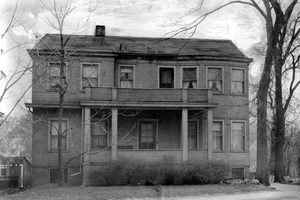 708 S. Adams Street
1875 – Our founding Sisters’ journey to the United States began in Germany, where they cared for children in an orphanage surrounded by extreme poverty. The Sisters were forced to leave after the "Iron Chancellor" of Germany sought to expel all religious groups. The Sisters came to the United States and ended up in Iowa City, Iowa, where they cared for orphans. They endured poverty so severe that they were forced to go on begging trips in order to have enough money to care for the children. On one such trip, they found their way to Peoria, Illinois where the Sisters met a German priest. The priest knew that Peoria desperately needed someone to care for the sick and asked them to stay. They returned to Iowa City where they were granted permission to return to Peoria and begin their new mission.
708 S. Adams Street
1875 – Our founding Sisters’ journey to the United States began in Germany, where they cared for children in an orphanage surrounded by extreme poverty. The Sisters were forced to leave after the "Iron Chancellor" of Germany sought to expel all religious groups. The Sisters came to the United States and ended up in Iowa City, Iowa, where they cared for orphans. They endured poverty so severe that they were forced to go on begging trips in order to have enough money to care for the children. On one such trip, they found their way to Peoria, Illinois where the Sisters met a German priest. The priest knew that Peoria desperately needed someone to care for the sick and asked them to stay. They returned to Iowa City where they were granted permission to return to Peoria and begin their new mission.
1876 – The Sisters begin caring for patients, in this home at 708 S. Adams Street in Peoria, on November 4. They took their ministry of caring for the ill into the community and suffered extreme poverty, prompted by the Franciscan custom of not charging for their services.
Late 1800s
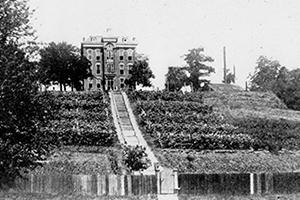 The property on the bluff before renovations.
The property on the bluff before renovations.
1877 – The first bishop of the newly created Peoria Diocese arrived in Peoria. He suggested the Sisters form a new order. On July 16, 1877 the ten Sisters took the name of The Sisters of the Third Order of St. Francis. In August, the Sisters acquired the property at 248 Bluff (now Glen Oak Avenue), which was owned by Lydia Moss Bradley (founder of Bradley University).
1878 – After extensive renovations, St. Francis Hospital opens with 35 patient beds.
1885 – To satisfy space needs, a north wing is added boosting the bed count to 53 and giving the Sisters a long-awaited chapel.
1890 – A south wing is added giving the hospital 95 beds, a kitchen, boiler room and a laundry room.
Early 1900s
1901 – Another six-story building is constructed giving the hospital 190 patient beds, two operating rooms and an emergency room.
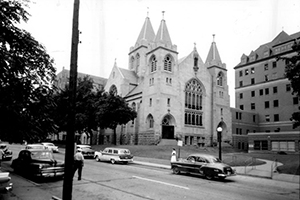 The Chapel of St. Francis.
The Chapel of St. Francis.
1909 – A new Chapel is dedicated on December 9 and cost $70,000 to build. It accommodates 400 worshippers.
1918 – Another new wing is added. St. Francis Hospital now has 350 patient beds, four operating rooms and a new lab and x-ray department.
1938 – St. Francis Hospital acquires Peoria's first iron lung to treat an eight year old boy with a rare respiratory disease.
1942 – A new, eight-story building replaced the original hospital on the bluff. It housed dietary, surgery, the psychiatric department, the lab, the orthopedic department and the delivery room. The hospital now has 500 patient beds.
1950 – Forest Park Home is dedicated in August after a final cost of about $1,000,000.
1951 – In December, doctors repair the aorta of a three-month old infant in the first heart surgery of its kind in Peoria. The baby's aorta had divided into two vessels and encircled his windpipe and esophagus.
1954 – On June 27, a new, 100-bed Children's Hospital is dedicated, the result of the first capital campaign in the history of OSF Saint Francis.
1968 – A seven year modernization and building project costing $7,000,000 was completed. It included the demolition of the oldest remaining portion of the hospital, adding two floors onto the Children's Hospital, a generator, a new emergency department, a 228-seat auditorium, lab, X-ray department, and board room. By the end of the year, St. Francis Hospital is an 800-bed facility.
1970s
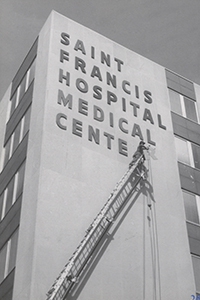 Workers update the name.
Workers update the name.
1972 – The state designated St. Francis as a regional trauma center covering 18 counties.
1973 – On February 1, two doctors performed the first open heart surgery Peoria on an 18-year-old woman who had a hole in her heart.
1974 – The hospital adds "Medical Center" to its name.
1976 – St. Francis acquires an EMI scanner, a radiological instrument to aid in the diagnosis of brain disease and injuries. The only one in Peoria, it is best known as a computed tomography (CT) scanner, it combines the speed and accuracy of a digital computer with highly sensitive X-ray detectors.
1980s
1980 – The medical center officially launches a children's heart surgery program, led by Dr. Dale Geiss.
1982 – The Radiology department installs a whole body CT scanner in March. The word "hospital" is dropped, as the institution's official name becomes Saint Francis Medical Center. In December, the medical center makes national news when it performs hemodialysis treatment on the smallest infant ever to be dialyzed. The little girl weighed 1 pound, 12 ounces.
1983 – The landscape of Saint Francis Medical Center and downtown Peoria changed dramatically on June 28 with the groundbreaking of a $47 million, seven-story addition to the medical center. The building would house a new emergency department, five intensive care units, radiology department, main lobby, coffee shop, patient registration, shuttle lobby, central supply, 36-bed cardiac stepdown unit, 36-bed medical nursing unit, and inpatient/outpatient recovery rooms for surgery.
1985 – On July 14, Dr. Beverley Ketel performs the first kidney transplant in central Illinois. Saint Francis introduces the lithotripter to Illinois with the opening of the Kidney Stone Center in June. The lithotripter is a non-invasive method of disintegrating kidney stones.
1986 – About 12,000 people attended the four days of opening festivities for the new addition to the medical center. It was announced that day that the building would be called the Gerlach Building in honor of Sister M. Canisia Gerlach, O.S.F., hospital administrator since 1960.
1987 – Peoria's first heart transplant took place at the medical center on April 27. On March 2, quintuplets are born at Saint Francis ranging in weight from one pound, 12 ounces, to two pounds, three ounces.
1989 – Saint Francis becomes the first Illinois hospital to mobilize a Cardiac Catheterization Laboratory, at a cost of $1.1 million. It is also announced that Saint Francis will form the Central Illinois Cardiac Emergency Network, which involves 12 hospitals and medical centers.
1990s
1990 – The formation of the Children's Hospital at Saint Francis Medical Center is announced. The Illinois Neurological Institute is formed to consolidate neurological services and improve clinical care, research and education in this field. The Susan G. Komen Breast Center opens. Saint Francis is the first downstate hospital with the diagnostic tool of flow cytometry, laser technology that examines cell interiors.
1994 – An urgent care facility, called "Prompt Care," opened on the main floor of the Glen Avenue Outpatient Center.
1995 – To create a system identity, the letters "OSF," representing Order of St. Francis, are added to the name of each medical center, including OSF Saint Francis Medical Center.
1997 – In February, the creation of the OSF Stroke Network is announced with 13 hospitals as charter members. With Dr. David Wang as director, it is the first such network in the United States to adopt uniform treatment protocols for stroke victims.
1998 – The Mother M. Frances Krasse Family Health Center is dedicated on July 16. The $2,000,000 facility on Peoria's south side began seeing patients in August.
2000s
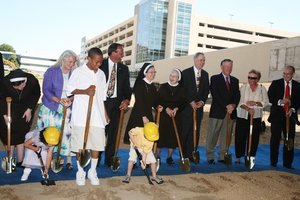 Milestone project groundbreaking ceremony.
Milestone project groundbreaking ceremony.
2000 – On February 15, a groundbreaking is held for RecPlex (later named RiverPlex), a joint effort between OSF Saint Francis and the Peoria Park District. The first use in central Illinois of an advanced heart procedure, transmyocardial revascularization, or TMR takes place. The Jim and Trudy Maloof St. Jude Affiliate Clinic is relocated to Children's Hospital in November.
2001 – Gamma Knife, a groundbreaking technology for neurosurgeons and radiation oncologist, is installed. The OSF Saint Francis Center for Health opens in north Peoria. It contains ambulatory surgery, lab, diagnostic radiology series, a PromptCare, women's services and doctors' offices.
2002 – Dr. Ketel performs the area's first pancreas transplant on September 6 and the first kidney-pancreas transplant on September 8. Robotic-assisted surgery is introduced.
2007 – In July, groundbreaking ceremonies were held on the downtown campus of OSF Saint Francis Medical Center as the Milestone Project officially began. The $234 million modernization and expansion of the medical center and Children’s Hospital of Illinois will take three years to complete. Three of the floors of the 440,000-square-foot building will be dedicated to Children’s Hospital, with one floor serving adult cardiac patients. The other four floors of the eight-story facility will contain services for both adults and children, including: surgery, emergency medicine and an admitting and lobby area. The St. Jude Affiliate Clinic will also move to the new building.
Present Day
2010 – Ten days of events surrounded the opening of the new Children's Hospital of Illinois/OSF Saint Francis Medical Center. The Bishop of the Peoria Diocese and political dignitaries attend the events. The project ends up costing $287 million dollars and is the largest construction project in the history of Peoria at this point.
